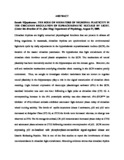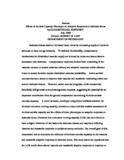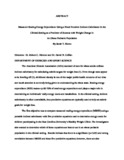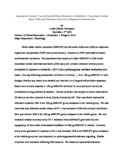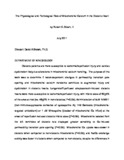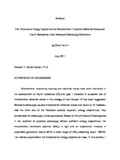Search
Now showing items 11-20 of 26
Influence of carbon nanomaterial exposure on pro-constrictor mechanisms during pregnancy
(East Carolina University, 2013)
Engineered carbon based nanoparticles (CNP) such as fullerenes and multiwalled carbon nanotubes (MWCNTs) are increasingly used in industries and in nanomedicine as a platform for drug delivery. Following environmental/o ...
ESTABLISHMENT OF THE PYRUVATE DEHYDROGENASE COMPLEX AS A CENTRAL REGULATOR OF MITOCHONDRIAL REDOX WITHIN SKELETAL MUSCLE
(East Carolina University, 2013)
Once regarded as "byproducts" of aerobic metabolism, the production of superoxide/H₂O₂ is now understood to be a highly specialized and extensively regulated process responsible for exerting control over a vast number of ...
The role of mediators of neuronal plasticity in the circadian regulation of suprachiasmatic nucleus by light
(East Carolina University, 2009)
Circadian rhythms are highly conserved physiological functions that are present in almost all living organisms. In mammals, circadian rhythms are synchronized to the environmental light:dark cycle by daily adjustments in ...
Effects of Aerobic Capacity Phenotype on Adaptive Responses to Ischemic Stress
(East Carolina University, 2009)
Ischemic disease leads to increased tissue stress by decreasing supply of nutrients adequate to meet energy demands. To maintain functionality, compensatory mechanisms for diminished vascular supply are induced by numerous ...
NADPH Oxidase as a Mechanistic Link Between Erectile Dysfunction, Peripheral, and Coronary Endothelial Dysfunction in Obesity
(East Carolina University, 2012)
Cardiovascular complications involving both microvascular and macrovascular tissues are the major cause of morbidity and mortality in obese patients. Clinical and epidemiological studies suggest that erectile dysfunction ...
Measured Resting Energy Expenditure Using a Fixed Function Indirect Calorimeter in the Clinical Setting as a Predictor of Success with Weight Change in an Obese Pediatric Population
(East Carolina University, 2010)
The American Dietetic Association (ADA) standard of care for obese adults utilizes indirect calorimetry for calculating caloric targets for weight loss (1). Even though rates appear to be leveling off (2), childhood obesity ...
Augmented coronary vascular smooth muscle response to endothelin-1 exacerbates cardiac injury following pulmonary exposure to engineered nanomaterials
(East Carolina University, 2014)
Multi-walled carbon nanotubes (MWCNT) and 60-carbon fullerenes (C60) are important engineered nanoparticles (ENP) used across industry. Exposure to ENP potentially promotes cardiovascular detriments. The hypotheses that ...
The induction of antigen-specific immunological tolerance and attenuation of inflammation via cytokine antigen fusion protein therapy in a mouse model of pulmonary inflammation
(East Carolina University, 2014)
Allergic asthma is a significant medical issue, affecting more than 300 million individuals and causing approximately 250,000 deaths each year. Current asthma therapies temporarily minimize discomfort and manage symptoms, ...
The Physiological and Pathological Role of Mitochondrial Calcium in the Diabetic Heart
(East Carolina University, 2011)
Diabetic patients are more susceptible to ischemia/reperfusion injury and cardiac dysfunction likely due alterations in mitochondrial calcium handling. The purpose of this work was to determine if redox-dependent changes ...
The Influence of Energy Expenditure on Mitochondrial Functions, Oxidative Stress and Insulin Resistance under Metabolic Oversupply Conditions
(East Carolina University, 2011)
Mitochondrial respiratory capacity and oxidative stress have been implicated in the development of insulin resistance (IR) and type II diabetes. A causative role of mitochondrial oxidative stress in the etiology of ...



